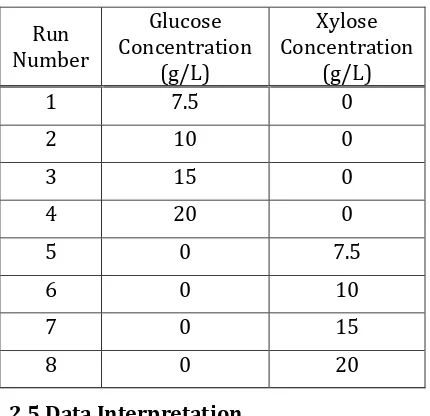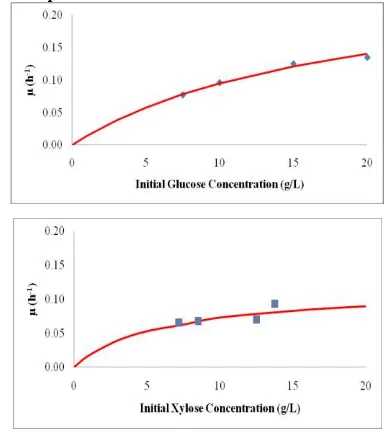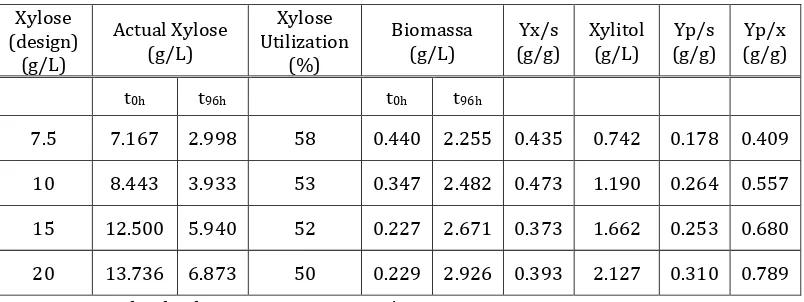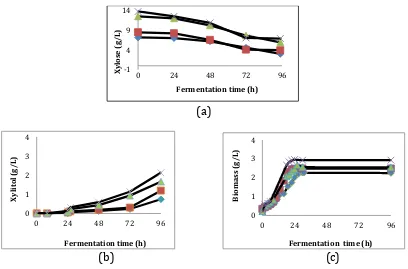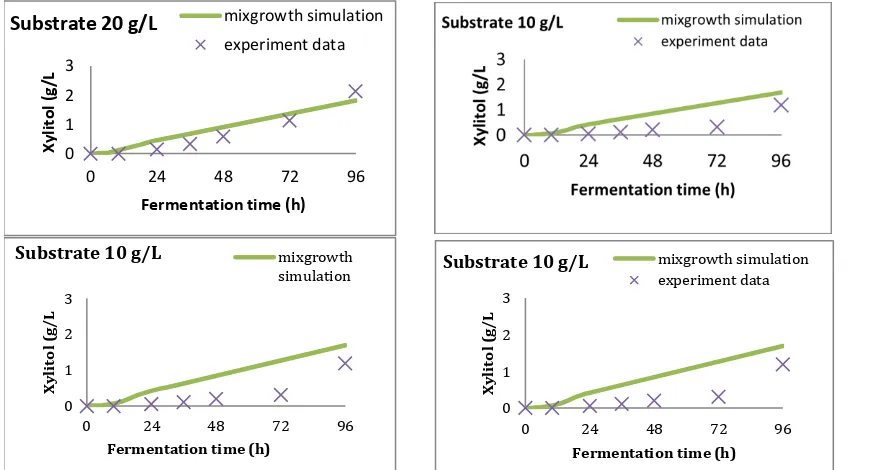Kinetic study on Fermentation of xylose for The Xylitol
Production
Efri Mardawati
*1, Andi Trirakhmadi
2, MTAP Kresnowati
2, and
Tjandra Setiadi
11Department of Agroindustrial Technology, Faculty of Agro-industrial Technology Universitas Padjadjaran, Jatinangor, Bandung, Indonesia
2Department of Chemical Engineering
Institut Teknologi, Bandung, Indonesia
Email: efri.mardawati@unpad.ac.id*
Abstract
Xylitol is a natural sugar that has the sweetness level similar to sucrose, but has lower calorie. It is an important sugar alternate for diabetics people. Reduction of xylose is a normally method to produce the xylitol. It conducted through chemical hydrogenation of xylose at high pressures and temperatures by reacting pure xylose with hydrogen gas using a metal catalyst. This process requires pure xylose as the raw material. Alternatively, the reduction process can be carried out through fermentation. This process does not require high purity of xylose as the raw material, and thus the oil palm empty fruit bunch (EFB) hydrolysate, without any prior pretreatment, can be used. In order to scale up the xylitol production by way of fermentation, kinetic study of xylitol fermentation including growth and xylitol formation kinetic using the synthetic xylose as substrate will be required. Data used in the kinetic model development were obtained from series of batch fermentations of Debaryomycess hansenii ITB CCR85 varying the initial xylose and glucose concentrations. Yeast growth could be sufficiently modeled using the Monod kinetics, whereas xylitol production could be reasonably well modelled by Luedeking Piret kinetics.
Keywords: fermentation, kinetic, model, xylitol, and xylose
. INTRODUCTION
Xylitol is a natural five-carbon sugar that is widely consumed by industries, including the food, chemical and pharmaceutical. Xylitol has the sweetness level equal to sucrose, but has low calorie value. Beside it is also an important sugar substitute for diabetics patients. It has a considerably negative heat of solution and low viscosity in Musatto et.al [1]. Xylitol is currently produced by the chemical reduction of xylose for example by contacting liquid xylose with pure hydrogen gas in Oh et. al [2]. This process is commonly carried out at non-atmospheric conditions in a batch reactor by using pure xylose and noble metal-based catalysts, such as nickel, palladium, ruthenium, and platinum in Parajo et. al [3], for example conducted this process at hydrogen partial
pressure of 20 bar and temperature of 80-120oC.
Alternatively, xylitol can be produced undergo biotechnologically processed by yeast fermentation [3,9]. Various of microorganisms were investigated for converting xylose into xylitol. Among these, the best xylitol producers are yeasts, mainly belong to the species Debaryomyces
hansenii in Converti et.al, Dominguez et.al
and Mardawati et.al [4, 5, 6]. D. hansenii is of particular interest because of the negligible formation of ethanol under semiaerobic conditions, which provide high xylitol yields in Converti et.al and Sampaio
et.al [4,7]. D. hansenii metabolize xylose
oxidized to D-xylulose by either NAD+-linked or NADP+-linked xylitol dehydrogenase (XDH) in Parajo et.al and Converti et.al [3, 4].
Xylitol production by yeasts is influenced by several factors including initial xylose concentration, the strain, presence of other sugars and its ratio, as well as fermentation conditions such as pH, temperature, oxygen supply, and the presence of inhibitor compounds in Parajo
et. al and in Silva et. al [8,9]. The other
critical factor in the fermentation of xylitol by yeast is medium. The high concentration of glucose in the medium may repress the activity of the key enzyme in convert the xylose into xylitol. Overall low yield of product is obtained in Silva et. al [9]. Oh et. al., 1998 reported an optimum xylose to glucose concentration ratio in the substrate to give the maximum xylitol production in
Oh et. al [2]. Beside that, Oxygen is
important for the xylose metabolism by yeasts, it is connected to ATP production, coenzyme regeneration, and sugar transport, throughtout the oxidative phosphorylation. Some yeasts need oxygen for an optimum xylose fermentation in Silva
et. al [9]. D. hansenii is ensures producing
high xylitol yields under microaerobic conditions in Converti et.al [4]. For that reason, it is a fundamental importance to understand the influence of substrate and cosubstrate factor effect on xylose to xylitol bioconversion for the improvement of an efficient technology for large-scale xylitol production by biotechnological process.
Many researchers reported aspects influencing the xylitol fermentation, but few researches reported the related kinetics aspect. Eventually, to scale-up the xylitol production to pilot scale and finally industrial scale, information on fermentation kinetics, such as specific rate of key reactions, which can only be obtained through kinetics modeling, is required. )n CCR was used in this study and obtained from Microbiology and Bioprocess Technology Laboratory of Chemical Engineering )TB. The yeast was grown in glucose yeast extract agar GYE for days at oC before further used.
. Fermentation
Fermentation process was carried out in a bioreactor with the volume of 1.3 L (New Brunswick BF115). The bioreactor is equipped with pH, temperature, level, dissolved oxygen (DO), and foam control system. Batch fermentation was executed in 700 mL working volume and 450 rpm mixing speed at pH 5 and temperature 30oC.
Inoculum used was 10% of working volume. The fermentation was sampled over time during the fermentation time. Fermentation is terminated when the culture reached the stationary phase. To study the effect of substrate type variation, aeration level was maintained at 0.5 vvm during the fermentation process. The system was aerated in 0.5 vvm aeration rate to simulate semi-aerobic environment.
. Analysis
Sample was analysed for biomass as cell concentration by the
turbidimetric-gravimetric method using UV-Vis
spectrophotometer. Xylose, glucose, and xylitol concentrations were determined
using high performance liquid
chromatography (PLC type BioRad Aminex (PX- ( column and mM ( SO as eluent as was described in Mardawati [ ].
. Experimental Design
Table 1. Summary of runs conducted in this
Growth of microorganisms were parameterised as the specific growth rate that was calculated from biomass concentration data during the logarithmic phase, following equation .
dXdt = μX however, the simplest model is formulated by Monod, as expressed in Equation and The kinetics parameters were estimated using the Lineweaver-Burk plot in Shuler
S = substrate concentration (g/L)
μmax = maximum specific growth rate (h-1) Ks = Monod constant g/L
. . Xylitol Production for D. hansenii
ITBCCR8 Growth on xylose substrate
)n order to measure the performance of a fermentation system, the yield values are used. The general statement of yield can be described as ratio of formed product
YP/S = Product-from-substrate yield (g xylitol/g xylose)
YP/X = product-from-cell yield ( g xylitol/g cell)
QP = The volumetric productivity (g/L/h)
. . Estimation of Product Formation Kinetic Parameter
Product formation is commonly stated in its specific rate form. Definition for specific product formation rate (qP) is expressed in Equation 6.
qP= 1
X dP
dt (6)
Generally, microbial products are classified into three categories (Shuler & Kargi, 2002), which are:
a. Growth-associated product
For a growth-associated product, product formation rate is proportional to growth rate.
qp= µ (7)
b. Non-growth-associated product For a non-growth-associated product, product formation rate is unaffected by growth rate.
qp= (8)
Non-growth-associated products include secondary metabolites.
non-growth-associated product (Equation 8), which is:
qp = µ +
3. Result and Discussions
3.1. Estimation of Monod Kinetics Parameters for D. hansenii Growth
Xylitol is produced from xylose substrate by yeast, but yeast needs the glucose as carbon source for their growth so that in fermentation media may also contain co-substrate. Xylose-to-xylitol fermentation mechanisms involve glucose as co-substrate. The effect of co-substrate existence is noteworthy, especially if fermentation is to be executed by using lignocellulosic hydrolysate, which consists of primarily xylose and glucose. In order to study the influence of each substrates on the cell growth, fermentation were conducted using either glucose or xylose as substrate. Specific growth rates (µ) of each runs were determined using Eq.2. Followingly, the calculated specificgrowth ratesfor glucose and xylose as substrate are presentedin Fig.1.
Fig.1 shows that the high concentrations of either glucose or xylose in the medium increase their consumption by the yeasts and consequently, enhances the
µ value. According to data from initial glucose concentrations of 7.5 g/L, 10 g/L, 15 g/L, and 20 g/L in Fig.1 a trend of µ
increase is observed in response to initial glucose concentration. The trend is the same with initial xylose concentrations effect on specific growth rate in Figure 1. In general Figure 1 shows that the specific growth rate of D. hansenii in xylose is lower than in glucose. This shows that D. hansenii
ITBCCR85 preferred glucose over xylose as the substrate for cells growth. Glucose is easier to consume than xylose. Tochampa
et.al in [11] explained that cells can produce
energy and biomass directly utilize glucose through glucose 6 phospaphate (Glu-6P), and consequently the HMP pathway slow down. In contrast, xylose metabolism by yeasts first supplementary xylose excreted into D-xylulose through an oxidoreductive
route consisting of two chronological reactions in Tochampa et.al [11]. The route of xylose is longer than glucose. Followingly, the Monod kinetic parameters were presented in Table 2.
Figure 1. The calculated specific growth rate values from D. Hansenii
using xylose and glucose as substrate (Experimental data and model)
Table 2. The Monod kinetics parameter of
D. hansenii growth.
Glucose Xylose
µ max(h-1) 0.27 0.11
Ks (g/L) 18.55 5.89
The values of KS and µmaxwere found to be 18.55 g/L and 0.270 h-1 for glucose, 5.89
g/L and 0.11 h-1 for xylose. Data showed
that KS value of D. hansenii growth on
glucose as substrate is higher than on xylose. It explains that D. hansenii
ITBCCR85 has low affinity to glucose, while its maximum growth rate is even higher than xylose.
Tochampa et.al in [11] studied Candida
mogii growth in the aerobic condition on
glucose and xylose, and found that KS= 9.998 g/L and µmax = 0.66 h-1 for glucose,
and KS= 11.761 g/L and µmax = 0.19 h-1 for
that D. hansenii ITBCCR85 has low affinity to glucose, while its maximum growth rate is even lower than C. mogii.
In general, the increase in xylose concentration in the substrate resulted in an increase in the produced xylitol concentration and xylitol yield (YP/S), except
for the run at initial xylose concentration of 15 g/L. In particular, the maximum product yield on substrate achieved is 0.310 g/g, which corresponds to xylitol volumetric productivity of 0.022 g/L/h. This value could still be improved because the xylose utilization is still low (max = 58%).
The productivity volumetric,QP,
productivities as well as the product yield on starting substrate, YP/S, were very low under conditions of substrate of 7.5 g/L, therefore the yeast could have not taken enough energy to grow and preferred to consume the carbon source for respiration and ATP production in Converti et.al [4]. The calculation of xylitol yield base on xylitol concentration per cell biomass (YP/X)
has the same phenomena, that the increase in xylose concentration resulted in the increase xylitol yield (YP/X), which is the
maximum (YP/X) of 0.860 g xylitol/g cell.
3.2. Estimation of Xylitol Formation
Kinetics Parameter
Xylitol production was observed from fermentation of D. Hansenii on xylose, because glucose can not be converted to xylitol. In Table 3, the yield of xylitol from each experiments are presented.
Similar phenomena was observed in literaters. Microbial production of xylitol
by D. Hansenii NRRL Y-7426 in Converti
et.al [4], the result showed that at relatively
low starting xylose substrate concentration (S0 = 50 g/L), xylitol formation was very interesting result for a potential industrial development of this fermentation process. It also stated that the rate of xylitol production increased similar with the increasing initial xylose in Dominguez et.al
[5]. Xylitol fermentation for the same strain resulted yield of 0.79 g/g at initial xylose concentration 279 g/L. A high concentration of xylose (279 g/L) was
converted rapidly and efficiently to produce xylitol with Qp of 4.6 g/L/h.
The profile of xylitol, biomass production and xylose utilization as long as fermentation time are presented in Fig.2. These figures show that xylitol production Table 3. The Effect of Xylose on Xylitol Yield.
Xylose
was started during the growth phase and the concentration reaches its maximum in the stationary phase. The calculation of specific product formation rate (qP) at each specific growth phase is presented in Table 4. alpha and beta are non zero. This indicates
that xylitol is produced both at the growth and stationary phase, which agrees with the observation. Validation of model was done with simulate this parameter to estimate the xylitol production in the fermentations time, further compared with the experimental result ( Fig.3).
CONCLUSIONS
The results showed that glucose is significantly easier to consume than xylose during the fermentaion of D. hansenii
ITBCCR85. The growth was observed to follow Monod kinetics model, with estimated parameters (KS and µmax) subsequently 18.55 g/L and 0.27 hour-1 for
glucose, 4.6 gL-1 and 0.10 hour-1 for xylose.
Xylitol formation was categorized as mix growth product, with product formation kinetics estimated to be qp = 0.006µ +
0.007. The maximum xylitol yield obtained in this work was 0,310 g/g which corresponds to volumetric productivity of xylitol of 0.022 g/L/h. These values were obtained from experiment with initial xylose concentration of 20 g/L.
ACKNOWLEDGEMENT
This research was funded by Directorate of Higher Education, Indonesian Ministry of National Education (DIKTI).
REFERENCES
[1] Musatto, S.I. Silva, C. and Roberto, I.C. Fermentation performance of Candida
guilliermondii for xylitol production on
single and mixed substrate media. Appl Microbiol Biotechnol 72,2006, 681– 686
[2] Oh, D.K. and Kim, S.Y. Increase of xylitol yield by feeding xylose and glucose in Candida tropicalis. Appl Microbiol Biotechnol 50, 1998, 419-425.
[3] Parajo, J.C. Dominguez, H. and Dominguez, J.M. Biotechnological production of xylitol. Part 1: Interest of Xylitol and Fundamentals of Its biosynthesis, Bioresource Technology 65, 1998, 191-201
[4] Converti, A. Perego, P. Sordi, A. and Torre, P. Effect of Starting Xylose
Concentration on the Microaerobic Metabolism of Debaryomyces hansenii. Applied Biochemistry and Biotechnology 101, 2002, 15-29
[5] Dominguez, J. Gong, C.S. , and Tsao. Production of Xylitol from D-Xylose by Debaryomyces hansenii. Applied Biochemistry and Biotechnology 63-65, 1997, 117-127
[6] Mardawati, E, Wira, D.W., Kresnowati., MTAP, Purwadi, R., and Setiadi, T. Microbial Production of Xylitol From Oil Palm Empty Fruit Bunches Hydrolysate : The Effect of Glucose Concentration, Journal of Jpn. Inst. Energy 94 (8), 2015, 769-774
[7] Sampaio, FC. Torre, P. Passos, FML. Moraes, CA. Perego, P. and Converti, A. Influence of Inhibitory Compounds and Minor Sugars on Xylitol Production by
Debaryomyces hansenii, Applied
Biochemistry and Biotechnology 136, 2003, 165-181 time for each initial xylose concentration
0
Substrate 20 g/L mixgrowth simulation
experiment data
Study of Some Strategies. Food Chemistry 57 (4), 1996, 531-536
[9] Silva, S.S. Felipe,, M. and Mancilha, I.M. Factors that Affect the Biosynthesis of Xylitol by Xylosa Fermenting Yeasts- A Review. Applied Biochemistry and Biotechnology 70-72, 1998, 331
[10] Shuler, M.L. and F. Kargi. Biopprocess Engineering Basic Concepts. Prentice-Hall, Inc. New Jersey, 1992
[11] Tochampa, W. Sirisansaneeyakul, S. Vanichsriratana, W. Srinophakun, P. Bakker, HH., and Chisti, Y., A. model of xylitol production by the yeast Candida
mogii, Bioprocess Biosyst Eng, 28(3),
